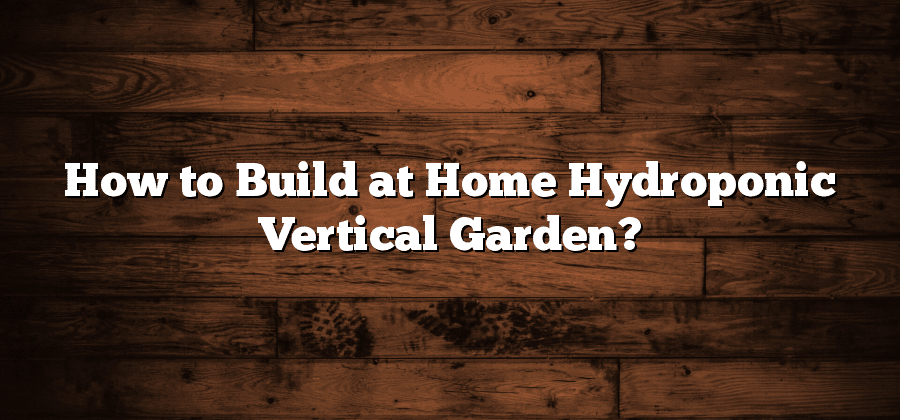Selecting the Right Vertical Garden System
When choosing a vertical garden system, it is important to consider several factors to ensure the success and longevity of your garden. Firstly, think about the available space in your home or outdoor area. Measure the dimensions and determine how much vertical space you have to work with. This will help you select a system that fits well and maximizes the use of your available space. Additionally, consider the weight-bearing capacity of your chosen location. Some vertical garden systems can be quite heavy, especially when fully planted, so it is essential to ensure that your chosen spot can support the weight without causing any structural damage.
Another crucial factor to consider when selecting a vertical garden system is the type of plants you wish to grow. Different systems have varying capabilities in terms of the types of plants they can support and the amount of space available for root growth. Some systems are specifically designed for growing herbs or smaller plants, while others offer more space for larger plants or vegetables. Therefore, it is essential to choose a system that aligns with your gardening goals and the type of plants you wish to cultivate. By carefully considering both the spatial requirements and plant suitability of different systems, you can ensure that you select the right vertical garden system for your specific needs.
Choosing the Ideal Location for Your Hydroponic Garden
Determining the right location for your hydroponic garden is a critical step in ensuring the success of your vertical garden system. The ideal location should provide the necessary elements for your plants to thrive, such as adequate sunlight, minimal or no exposure to harsh weather conditions, and easy access to water and nutrients.
First and foremost, consider the amount of sunlight your hydroponic garden will receive. Most plants require at least six to eight hours of direct sunlight each day for optimal growth. Therefore, it is essential to choose a location that receives ample sunlight throughout the day. Ensure that the chosen area is not obstructed by buildings, trees, or other structures that may cast unwanted shade on your plants. Additionally, consider the direction in which the sunlight hits the chosen location, as this will determine the distribution of light and the positioning of your plants within the vertical garden system.
Understanding Hydroponic Principles and Techniques
Hydroponics is a soilless gardening technique that allows plants to grow in nutrient-rich solutions. In this method, plants are not planted in soil but rather supported by various growing media such as perlite, vermiculite, or coconut coir. This technique offers numerous advantages, including faster growth rates, higher yields, and better control over plant nutrition.
One of the key principles of hydroponics is the delivery of essential nutrients directly to the plant roots through the nutrient solution. This solution contains all the necessary elements required for plant growth, including macronutrients such as nitrogen, phosphorus, and potassium, as well as micronutrients like iron, zinc, and manganese. By providing the precise amount of nutrients required by each plant, hydroponic systems ensure optimal growth and development.
To successfully implement hydroponic principles, it is essential to understand the different techniques available. These include the nutrient film technique (NFT), deep-water culture (DWC), and vertical growing systems. Each technique has its own advantages and considerations, such as the amount of water required, the level of maintenance needed, and the complexity of the setup. By carefully selecting the most suitable technique for your specific needs and resources, you can maximize the potential of your hydroponic garden.
Sourcing Quality Materials for Your DIY Vertical Garden
Quality materials are the foundation of any successful DIY vertical garden project. Investing in durable and reliable materials will ensure the longevity and stability of your garden. When sourcing materials, prioritize those that are specifically designed for vertical gardens to optimize their functionality and efficiency. Look for sturdy and weather-resistant materials that can withstand the elements and support the weight of your plants. Consider using materials such as galvanized steel for the framework, high-quality irrigation systems, and breathable yet sturdy fabric for the planting pockets. By selecting the right materials, you will set yourself up for a thriving and resilient vertical garden that will bring beauty and functionality to any space.
In addition to quality, it is also important to consider the sustainability of the materials you choose. Opt for eco-friendly options that minimize the environmental impact of your vertical garden. Look for materials that are made from recycled or upcycled materials, as well as those that can be easily recycled or repurposed at the end of their lifespan. Consider using organic or compostable fabric for the planting pockets, and explore options for sustainable irrigation systems that conserve water. By being mindful of the environmental footprint of your materials, you can create a DIY vertical garden that not only enhances your space but also contributes to a more sustainable future.
Constructing the Framework for Your Vertical Garden
Constructing the framework for your vertical garden is a crucial step towards creating a successful and aesthetically pleasing green space. The framework provides the necessary structure and support for your plants to grow vertically, allowing them to thrive in a limited space. When constructing your vertical garden framework, it is important to consider the materials you will use and the design layout that best suits your needs.
One of the key considerations when constructing the framework for your vertical garden is the choice of materials. The selected materials should be durable, weather-resistant, and able to withstand the weight of both the plants and the water irrigation system. Common materials for vertical garden frames include metal, wood, and PVC pipes. Each material has its own advantages and disadvantages, so it is essential to choose one that matches your specific requirements and budget. Additionally, proper installation of the framework is crucial to ensure stability and avoid any risk of collapse.






